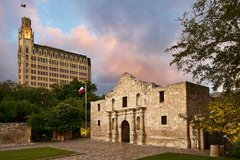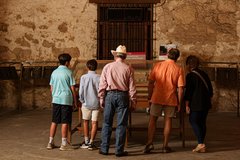Dr. R. Bruce Winders, Former Alamo Director of History and Curator
Ask many visitors who come to see the Alamo and they will tell you that the “Alamo” is the stone building with a rounded hump on top of it that faces the plaza. Even with all its hustle and bustle, though, the area known as Alamo Plaza is just as much the “Alamo” as the old historic church. Here is why.
Indigenous people had been visiting the headwaters of the San Antonio River for thousands of years before the arrival of the Spanish in the 17th century as they expanded out of northern Mexico. Archeologists have located numerous indigenous camps in the Olmos Basin and other nearby locations that reveal their presence. In addition to water, the area’s mild climate and convergence of plant and animal life provided them the necessities that nomadic tribes needed while living in south Texas. In addition to the Spanish, the Apache and Comanche entered Texas at the dawn of the 18th century, carried by horses they had acquired from Spaniards in New Mexico.
Spanish interest in Texas increased after French explorer La Salle founded a settlement in Matagorda Bay in 1685. Although short-lived, the French presence on land claimed by Spain caused officials to send expeditions across Texas. Soldiers and priests passing by the headwaters of the San Antonio river noted that it would be an excellent location for a Spanish community. In 1718, Spanish officials founded Mission San Antonio de Valero on the west side of the river; however, by 1724 a series of events cause them to relocate it to the present site of the Alamo.
Missions like Valero were Native American villages or pueblos where missionaries gathered prospective converts together to undergo the process of becoming Spanish subjects. Structures such as the convento, granary, workshops, and Native American quarters were construction around an empty space, which would become the town’s main plaza where religious and civic events were held. By the 1740s, the buildings surrounding the plaza had been connected, forming a fortified village for protection against Apache raiding parties. This incarnation of the mission compound built around its central plaza existed for the next one hundred years. When Valero was secularized in 1793, families still living there were granted houses along the west wall in which they were living, the first step in breaking up the compound according to ownership.
In 1803, the Louisiana Purchase placed the United States on the Spanish province’s eastern border, prompting fear that Americans would take advantage of the situation to seize Texas. In response, Spanish officials ordered a military buildup in San Antonio. The Alamo Company (La Segunda Compañía Volante de San Carlos de Parras) took up quarters in the former mission compound and the plaza became their parade ground. This period was marked by republican threats to Spanish royal authority as exampled by the Las Casas Revolt (1811), the Gutiérrez-Magee Expedition (1812), and the Battle of Medina (1813). Both the rebels and royalists kept prisoners inside the Alamo.
Mexican independence still found soldiers inside the Alamo, however, they now owed their allegiance to Mexico. Members of the Alamo Company continued to patrol the frontier, guarding against Comanche raiding parties and foreigners attempting to evade the nation’s colonization laws. Béxar’s designation as the capital of the Department of Texas in the Mexican state of Coahuila y Tejas ensured that it played a central role in the revolt sparked by the government’s abandonment of the Federal Constitution of 1824. While the majority of fighting during the 1835 Battle of Béxar occurred across the river near San Fernando Church, the Alamo took center stage in the famous 1836 battle when the old mission plaza was soaked with blood of both its Mexican attackers and its Texian and Tejano defenders. Before evacuating the town in May 1836, General Andrade ordered the defensive walls surrounding the plaza knocked down. With that act the plaza went from being enclosed to an open area once again.
The Alamo came as close to being abandoned as it ever would during the Republic of Texas (1836–1845). Fearing attacks by the Mexican Army or Comanche raiders, many of the residents of San Antonio had left. Those brave enough to stay struggled to rebuild their lives. Officially, the old mission property, excluding the houses along the west wall which had been given to Native American converts in 1793, still belonged to the Catholic Church. The city council, though, refused to recognize the church’s claim and sold stone from the Alamo’s ruins to anyone in need of building material. One enterprising resident, Samuel A. Maverick, purchased two of the old Indian residences on the old west wall and moved his family in while he waited for a two-story frame house to be built at the northwest corner of the plaza. Maverick, a member of the Alamo garrison sent out prior to the March 6 battle, said that he wanted to live where he could look out over where his friends had been killed. He and his family later played an even larger and more lasting role in the plaza’s development.
Texas’ annexation to the United States in 1845 heralded a big change for the Alamo. Since it was widely known as a fort, the U.S. Army seized the Alamo property for use as a supply depot. After extensive renovations, the quartermaster department moved into the Long Barrack in 1847 and the Alamo church in 1850. The Low Barrack, located at the south end of the plaza, became a granary while horseshoeing stations occupied the area of the old north wall. Maverick turned his property along the west wall into a lumberyard. South of the plaza, William Menger built a lodging house in 1859 called the Menger Hotel. Other businesses quickly sprang up around the plaza, drawn by the increasing commercial activity in the area. The U.S. Army left Texas in 1861 at the start of the Civil War but returned in 1865 and resumed quartermaster activities at the Alamo.
San Antonio gained a reputation as a cattle town in the years directly following the war. The town council passed ordinances which banned overnight wagon parking in the plaza and forbade cowboys from racing through it. On most days, a thick cloud of dust filled the air around the plaza kicked up by passing livestock. Any rain, though, turned the plaza into what local residents referred to as the “frog pond.” In 1876, a demonstration took place in the plaza that proved to skeptical cattlemen barbed wire’s effectiveness in keeping Texas long horns inside a wire enclosure. This event was important because it spelled the end of open range as ranchers began fencing their spreads, setting off a spat of range wars.
The plaza, however, was about to undergo big changes as the San Antonio boom times finally arrived. Eager to shed both its frontier reputation and appearance, city officials worked to develop the plaza. Their plans were aided by the fact that the Catholic Church decided to relinquish control of the Alamo’s plaza and its remaining structures. In 1871, the city purchased the plaza and the Low Barrack at its south end, demolishing the historic gatehouse to make way for a city meat market. Two important events occurred in 1877 that shaped the plaza’s future. The city arranged for the U.S. Army to leave the Alamo for a different location on the edge of town. By moving to Government Hill, the future site of Fort Sam Houston, the army could concentrate all its activities in one place instead of having various facilitates spread out over the city. That same year, Honore Grenet purchased the Long Barrack from the archdiocese and converted the building into a store and warehouse. Another important step was taken in 1883 when the State of Texas bought the old church building to serve as a memorial to the Alamo defenders. Soon the area had a U.S. Post Office, Grand Opera House, banks, cigar shops, drugstores, a fountain with running water, and even public restrooms. The city solved the problem of mud in 1889 by paving the plaza with blocks made of mesquite wood. By the turn of the century, the area around the plaza had traded its frontier features for that of a refined eastern city. A trolley line even ran down Alamo Street.
The conflict between commercial development and reverence deserved by the sacrifice of the Alamo’s defenders was apparent to both townspeople and visitors. By the late 19th century, a preservation movement had developed in the United States. In Texas, the Daughter of the Republic of Texas (DRT), an organization comprised of descendants of early Texans, fought to prevent further harm from coming to the Long Barrack when the building’s current owners offered to sell it. In 1905, the State Legislature granted the DRT custodianship of the two historic buildings, the Church and the Long Barrack, an arrangement that lasted until 2011 when authority over the Alamo passed to the Texas General Land Office. In 2015, the City of San Antonio and the State of Texas signed a joint management agreement concerning Alamo Plaza after the State purchased the three commercial properties located along west wall of the original mission compound. Additionally, that year, the San Antonio Missions, including Valero, received World Heritage Designation from UNESCO. A master plan currently under development that aims to make sure that visitors know the historical significance of the plaza so that they will know that there is more to the “Alamo” than just the church.



